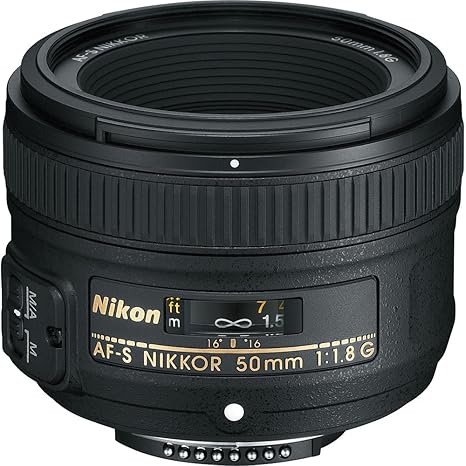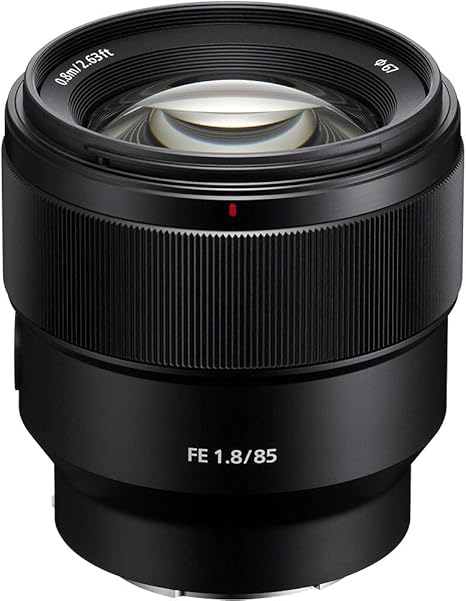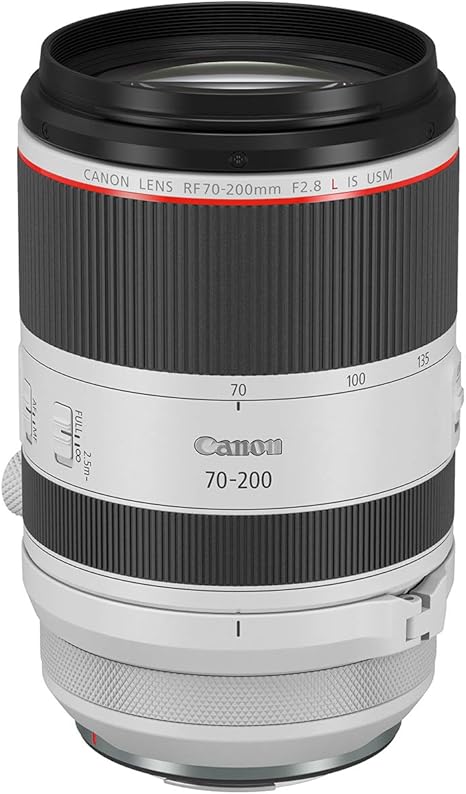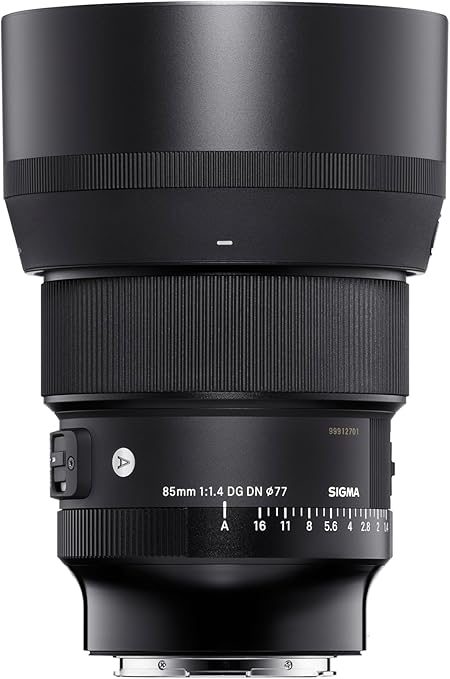Have you ever noticed how some engagement photos really seem to capture a couple’s connection beautifully? Often, the secret lies not only in the photographer’s skill but also in the quality of the lens used! Experience from countless engagement sessions in diverse settings shows that choosing the right lens can elevate a photoshoot into a cherished collection of memories for couples.
Table of Contents
- Introduction to Professional Lenses for Engagement Photography
- Types of Lenses for Engagement Photography
- Lens Specifications for Engagement Photography
- Frequently Recommended High-Performance Lenses
- Side-by-Side Comparison: How Lens Choice Affects Your Engagement Images
- Conclusion: Elevating Your Engagement Photography with the Right Lenses
Introduction to Professional Lenses for Engagement Photography

As engagement photographers, the lenses we choose directly influence the stories our images tell. While camera bodies evolve, quality lenses often serve as reliable workhorses in professional photography for years, even decades! Let’s explore why lens selection is so impactful and what features we should look for, drawing from technical insights and real-world applications.
Understanding the Importance of Quality Lenses
Capturing the genuine connection between a newly engaged couple deserves exceptional glass. High-quality lenses render subtle details—like the sparkle of an engagement ring, a tender look, or hands gently touching—with impressive clarity and depth.
This often becomes clear early in a photographer’s journey. For instance, shooting with a standard kit lens at a popular location like Griffith Observatory, even with a lovely couple and a great sunset, might result in images where the couple doesn’t stand out from the background crowds. Switching to a professional prime lens, such as a 50mm f/1.8, can make an immediate difference! Suddenly, couples appear distinct and separated, seemingly in their own world, even amidst busy surroundings.
Investing in Image Dimension and Feeling
When we invest in premium glass, we’re investing in our ability to create images with noticeable dimensions and feelings. According to Amateur Photographer’s 2025 Awards, lenses like the Sigma 50mm F1.2 DG DN Art are noted for their “ultra-bright aperture, sharpness, and smooth focus roll-off.” They deliver remarkable resolution and contrast even wide open—qualities that truly make engagement portraits stand out!
Key Features to Consider for Engagement Shoots
When searching for the best lens for engagement photos, aperture speed is often a top priority. Lenses featuring maximum apertures of f/2.8 or wider (like f/1.8, f/1.4) offer fantastic creative control! They allow us to shoot effectively in challenging lighting conditions and achieve that wonderful shallow depth of field, which helps couples appear beautifully isolated from their background.
Consider a scenario where an engagement session unexpectedly extends into the blue hour. Using a fast lens, like a Sony FE 85mm F1.8, makes it possible to continue shooting well past sunset. This allows for atmospheric portraits, perhaps with city lights creating lovely bokeh in the background! Trying to capture similar shots with a slower f/4 or f/5.6 zoom lens might necessitate flash, altering the mood of the images entirely.
Focal length shapes our storytelling approach. Wider focal lengths (24-35mm) are excellent for environmental portraits that highlight the location. Standard focal lengths (around 50mm) tend to produce natural-looking compositions. Longer focal lengths (85mm and up) compress perspective beautifully, flattering subjects while creating soft, blurred backgrounds.
We shouldn’t forget practical considerations like weight and build quality! Engagement sessions often involve moving between locations, and a heavy lens can become tiring over a multi-hour shoot. Weather sealing is also a worthwhile feature to protect equipment when shooting outdoors in unpredictable weather.
Types of Lenses for Engagement Photography

When building an engagement photography kit, the main choices fall between prime and zoom lenses. Each type presents distinct advantages that can enhance our work in different situations. Understanding these differences helps us select lenses that align with our shooting style and client needs.
Prime Lenses: Pros and Cons
Prime lenses possess a fixed focal length—they don’t zoom. Surprisingly, this limitation often becomes their greatest strength! With fewer moving parts and simpler optical designs, primes generally deliver superior image quality, remarkable sharpness, and significantly better low-light performance due to their wider maximum apertures.
The fixed focal length encourages more intentional composition during engagement sessions. Instead of zooming with the lens, we physically change our position, frequently discovering more creative angles and thoughtful framing. This deliberate approach can lead to more authentic captures and unexpected artistic findings!
The trade-off? We might need to switch lenses more often to achieve different compositions. This process takes time and introduces a slight risk of dust reaching the camera sensor. For sessions involving multiple locations or quick transitions, carrying several prime lenses also adds weight to the camera bag.
50mm f/1.8 – The Versatile Performer
Often nicknamed the “nifty fifty,” this lens is frequently the first prime added to an engagement photographer’s kit, and for good reason! With a perspective similar to human vision, 50mm lenses create natural-looking images that feel authentic. This focal length strikes a great balance between showcasing the couple and including enough background context to tell their story.
Imagine a session at a meaningful location, like the coffee shop where a couple had their first date. A 50mm lens can effectively capture both their connection across the table and the subtle details that make the setting special. The moderate wide aperture creates a sufficient depth of field to keep both partners sharp while gently blurring the familiar background—preserving the location’s atmosphere without distracting elements.
The 50mm f/1.8 performs especially well for walking shots, casual interactions, and environmental portraits. Its relatively wide aperture creates pleasing background separation while keeping enough depth to maintain sharpness on both partners when they are positioned similarly relative to the camera. Photography Hero confirms this versatility, stating that “a 50mm prime lens works well for natural, ‘lifestyle’ looks,” making it quite suitable for engagement photography!
85mm f/1.8 – Excelling at Portraits
When aiming for flattering portraits with soft, dreamy background blur, the 85mm f/1.8 is a definite favorite among many engagement photographers! This short telephoto focal length gently compresses facial features in a very pleasing way. It also creates a creamy, smooth bokeh that can make couples look beautifully separated from their surroundings.
The impact of an 85mm lens can be quite apparent during shoots in busy locations, like a popular beach. Even on a crowded summer day, a lens like the Sigma 85mm F1.4 Art can effectively dissolve background distractions into an attractive blur, while maintaining a sharp focus on the couple. What might have been a visually cluttered scene transforms into an intimate portrait, almost as if they had the entire beach to themselves!
The 85mm focal length allows for a comfortable working distance, which can help camera-shy couples relax, while still enabling us to capture intimate close-ups and genuine interactions. According to a 2024 review from professional wedding photographers, lenses such as the Sigma 85mm F1.4 DG DN Art are “ideal for portraiture and engagement photography due to excellent subject isolation and natural perspective,” frequently holding their own against first-party options.
Zoom Lenses: Pros and Cons
Zoom lenses offer incredible versatility, allowing us to adjust the focal length without needing to swap lenses. This flexibility is invaluable during engagement sessions where we might need to shift from a wide environmental shot to a tight portrait very quickly!
Professional zoom lenses with constant apertures (often f/2.8) have improved significantly in recent years. They now approach prime lens quality in many aspects while offering far greater compositional freedom. They prove especially useful for documentary-style engagement sessions where pausing to change lenses could mean missing spontaneous interactions.
What are the main drawbacks? Compared to primes, zooms might exhibit slightly reduced image quality, are generally heavier, and typically have slower maximum apertures, which can limit performance in low light. They also tend to represent a larger initial investment compared to individual prime lenses.
24-70mm f/2.8 – The All-Rounder
If limited to just one lens for engagement photography, many professionals might suggest the 24-70mm f/2.8. This zoom range covers everything from wide-angle environmental shots to flattering portraits, making it perhaps the most versatile single lens for engagement work!
At the 24mm end, we can capture expansive landscapes showcasing dramatic locations or include architectural elements significant to the couple. At the 70mm end, we can create intimate portraits with pleasing background compression. The constant f/2.8 aperture throughout the zoom range provides consistent exposure and decent background blur regardless of the focal length used.
A common technical challenge—maintaining both creative flexibility and professional image quality during dynamic sessions—can often be addressed by adding a high-quality zoom like the Sony FE 28-70mm F2 GM to the kit. Imagine an urban engagement shoot moving rapidly between narrow alleyways, open plazas, and indoor spots. The ability to quickly adjust the focal length while maintaining a constant f/2 aperture (which is faster than traditional f/2.8 zooms!) means adapting instantly to changing environments without sacrificing image quality or needing to stop and change lenses. What a workflow improvement!
70-200mm f/2.8 – Capturing Candid Interactions From Afar
For those wonderful candid interactions when couples seem to forget the camera is present, the 70-200mm f/2.8 becomes an incredibly useful tool! This telephoto zoom allows us to photograph from a distance, giving clients space to interact naturally without feeling closely watched. The results are often among the most genuine images in the final gallery.
The significant background compression this lens produces can make even ordinary locations look quite appealing by isolating subjects against creamy, indistinct backgrounds. It’s particularly effective for engagement sessions in busy public areas where we want to visually minimize distractions.
Consider photographing a proposal from a popular viewpoint. A 70-200mm lens allows the photographer to remain unnoticed until after the big question! This helps capture truly authentic reactions—something harder to achieve when standing closer with a wider lens. The strong telephoto compression can also transform even a less-than-ideal background, like a parking lot, into an attractive wash of colors, showing how this lens can elevate challenging locations.
Lens Specifications for Engagement Photography

When selecting the best lens for engagement photos, understanding the technical specifications helps us capture those unique, once-in-a-lifetime connections. We can explore the features that differentiate professional-grade lenses from average ones, guiding smart investments that will elevate our engagement photography work!
Aperture Speed: Why Fast Lenses Matter
A lens’s maximum aperture might be the single most vital specification for engagement photography. Faster lenses—those with wider maximum apertures like f/1.2, f/1.4, or f/1.8—permit significantly more light to reach the camera sensor. This light-gathering capability transforms our shooting possibilities in several key ways!
First, fast apertures enable shooting in difficult lighting without needing to drastically increase ISO, which can introduce unwanted noise. Whether capturing a sunset proposal or an intimate exchange in a softly lit restaurant, a fast lens can mean the difference between a clean, vibrant image and one that’s grainy or underexposed.
Creating Subject Separation and Bokeh
Perhaps more visibly, wide apertures create that characteristic shallow depth of field that makes professional engagement photos so distinct. This selective focus draws the viewer’s eye directly to the couple while rendering backgrounds into soft, pleasing blurs. The quality of the bokeh—the aesthetic appearance of those out-of-focus highlights—adds a romantic quality that clients often associate with professional work!
Demonstrating this difference in workshops, by shooting the same composition with different apertures, often highlights the impact. The contrast between an f/5.6 image and an f/1.4 image of the same scene is usually quite striking, not merely technically but in feeling. The shallow depth of field fosters an intimacy that perfectly complements the romantic nature of engagement photography!
Optimal Focal Lengths for Different Scenarios
No single focal length is perfect for every engagement situation! Our choice should align with both the shooting environment and the feeling we aim to convey.
For environmental portraits showcasing meaningful locations, wider focal lengths between 24-35mm allow us to include context while keeping the couple as the clear focal point. These wider perspectives work well in urban settings, with interesting architecture, or in scenic landscapes where the location itself helps tell the couple’s story.
The 50mm focal length offers the most natural perspective, closely resembling human vision. This tends to create images that feel authentic and approachable—great for capturing genuine interactions between partners! It’s versatile enough for both environmental shots and closer portraits, making it an excellent starting point when building an engagement photography kit.
Flattering Portraits and Subject Isolation
For classic portrait work where facial features and expressions are paramount, the 85mm focal length has certainly earned its reputation. This short telephoto length creates very flattering compression for faces while providing enough working distance to help couples feel comfortable and behave naturally.
For truly dramatic portraits or candid captures from a respectful distance, longer focal lengths like 135mm or the 70-200mm zoom range create outstanding subject isolation. They compress backgrounds effectively, making even simple locations look quite remarkable!
A significant technical consideration engagement photographers often navigate is maintaining a pleasing perspective while switching between focal lengths. Photography forums indicate that many photographers work hard to keep both subjects sharp within a narrow depth of field, especially when photographing two people at slightly different distances from the camera. This is where understanding the interplay between focal length, aperture, and subject distance becomes so valuable—knowledge often honed through numerous engagement sessions in varied conditions!
Image Stabilization: Enhancing Sharpness
Image stabilization technology (labeled variously as IS, VR, OSS, or IBIS depending on the brand) has become increasingly advanced! It enables sharp handheld shots in conditions that previously might have required a tripod. This feature proves particularly helpful for engagement photography, where spontaneous interactions don’t always wait for a perfect setup.
One notable lens technology improvement between 2023 and 2025 involves advancements in AI-enhanced autofocus and image stabilization systems. Modern stabilized lenses now often allow shooting at significantly slower shutter speeds—sometimes 3-5 stops below the traditional “1/focal length” guideline. This capability extends the shooting window during golden hour as light fades, or permits indoor sessions without needing disruptive flash equipment. What a difference this makes!
For engagement photographers frequently working in natural or low light, prioritizing stabilized lenses can dramatically increase the percentage of technically successful images, especially when used alongside wide apertures.
Autofocus Speed and Accuracy
Even the most optically superb lens isn’t effective if it can’t focus precisely when needed! Modern engagement sessions often involve movement—couples walking, dancing, or interacting dynamically—making autofocus performance highly important.
When evaluating lenses, we should consider both focus speed and accuracy. High-end lenses typically feature more sophisticated motors (like USM, HSM, or linear motors) that deliver faster, quieter focusing. This becomes particularly relevant when shooting candidly, as the sound of a lens hunting for focus might interrupt authentic exchanges.
Focus accuracy is even more critical with wide-aperture lenses, where the depth of field can be extremely shallow. Recent developments in AI-driven autofocus systems, such as eye-tracking and predictive tracking, now help achieve pinpoint accuracy even in dynamic scenarios. This is a fantastic advancement for engagement photography, where capturing candid interactions and natural expressions is a high priority!
Frequently Recommended High-Performance Lenses

Based on extensive professional use and testing across various conditions, certain lenses consistently rise to the top for engagement work due to their technical performance and real-world usability. Here are three lenses frequently recommended by professionals for delivering exceptional results:
Sony FE 35mm F1.4 GM – The Environmental Portrait Master
This lens is often favored for storytelling engagement images that incorporate meaningful locations while keeping the couple sharply in focus. The 35mm focal length provides a natural, immersive perspective, mirroring how couples experience their surroundings. The f/1.4 aperture allows for beautiful separation even within environmental compositions!
What makes this lens stand out is its combination of edge-to-edge sharpness and attractive rendering. Unlike many wide-angle lenses that can soften towards the frame’s edges, this G Master lens maintains exceptional detail throughout. This allows photographers creative freedom to place couples anywhere in the composition without compromising quality.
Imagine an engagement session at a location like Huntington Gardens. This lens can capture the couple framed by blooming cherry blossoms, with both elements perfectly sharp—a result potentially difficult with lesser glass. Its fast, silent autofocus also makes it well-suited for capturing those spontaneous laughs and interactions that truly define great engagement sessions!
When to use it: Professionals often rely on this lens whenever the location plays a significant role in the couple’s story—think of historic architecture, scenic landscapes, or meaningful venues where context enhances the narrative. It’s also a preferred choice for active engagement sessions involving movement and exploration.
Sigma 85mm F1.4 DG DN Art – Excelling at Portraits
For sheer impact in portraits, the Sigma 85mm F1.4 Art is frequently cited as a top performer! This lens creates a wonderful combination of compression, subject isolation, and smooth bokeh that can transform ordinary scenes into striking portraits. The 85mm focal length is ideal for tighter compositions that highlight expressions and connection.
What sets this Sigma apart from many other 85mm options is its exceptional performance wide open at f/1.4. While some lenses require stopping down to f/2 or f/2.8 for optimal sharpness, this lens delivers tack-sharp details on subjects while maintaining creamy backgrounds right at its maximum aperture! Professional reviews often note that this Sigma “surpasses the Sony FE 85mm F1.4 GM in many areas, including autofocus silence and build quality,” aligning with widespread user experience.
A technical challenge this lens helps overcome is capturing intimate portraits within distracting environments. During a session at a busy beach boardwalk, for instance, this lens can effectively dissolve the potentially chaotic background into an attractive wash of colors, facilitating intimate portraits despite nearby activity.
When to use it: This lens is a primary choice for creating close-ups full of feeling, capturing intimate interactions, and producing those dreamy, portfolio-worthy portraits that clients often adore for wall art and album covers!
Sony FE 70-200mm F2.8 GM II – The Storytelling Telephoto
While prime lenses form the core of many kits, this telephoto zoom earns its place through unmatched versatility in storytelling from a distance. The ability to quickly adjust from 70mm environmental context shots to 200mm compressed portraits without changing physical position can help capture countless authentic interactions during engagement sessions!
What’s particularly impressive is how this lens handles challenging lighting. The combination of a constant f/2.8 aperture with excellent image stabilization means photographers can often shoot handheld well into the blue hour. This allows for capturing those lovely twilight scenes that might otherwise be missed due to technical limitations!
A specific situation where this lens shines is photographing shy couples who benefit from having some space to feel natural. In sessions with a nervous couple, stepping back 40-50 feet and shooting at the 200mm end gives them room to interact without the immediate pressure of a camera nearby. The resulting images often capture authentic connections that might have been harder to achieve standing closer with a standard lens.
When to use it: This lens excels for candid, documentary-style engagement coverage, proposal photography where discretion is needed, and sessions in busy public locations where physical distance helps isolate the couple from background distractions.
Side-by-Side Comparison: How Lens Choice Affects Your Engagement Images
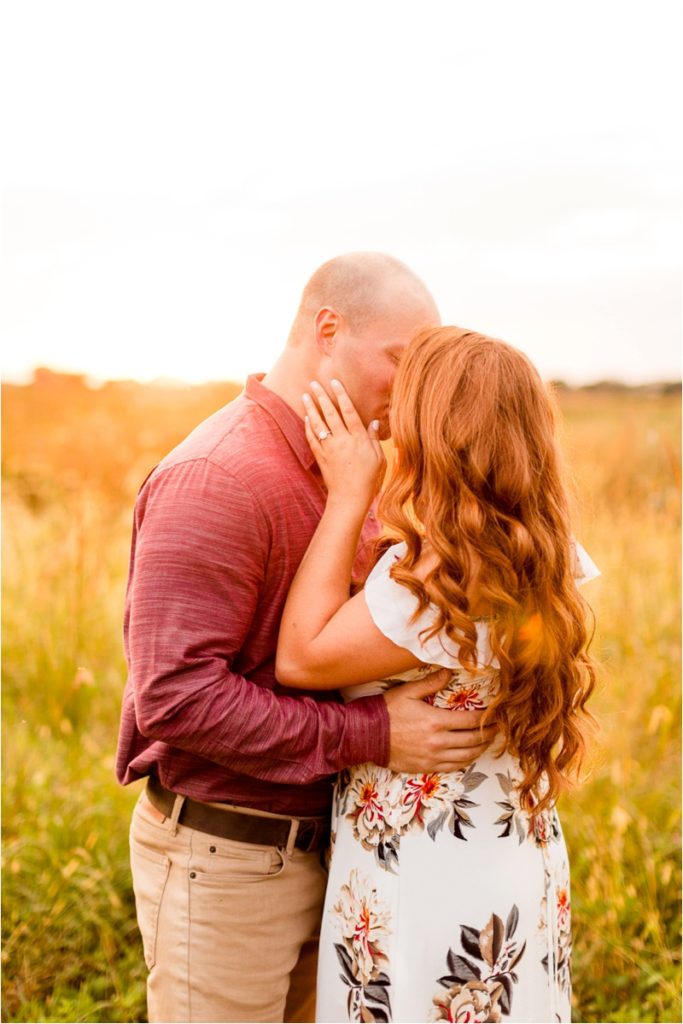
To illustrate the practical differences lens choices make, consider a controlled test during a styled engagement shoot. Using the same couple, location, and lighting, photographing identical poses with different lenses clearly demonstrates how focal length and aperture impact the final image:
The Environmental Portrait (35mm f/1.4)
With the 35mm lens, we capture both the couple and the surrounding historic architecture. The wide field of view establishes context while maintaining subject prominence. The f/1.4 aperture creates enough background separation to make the couple stand out, yet keeps architectural details recognizable—perfect for couples who want their location featured in their story! Technical aspect addressed: Balancing environmental context with subject emphasis. The wide aperture helps make the couple prominent within a wider scene that includes important background elements.
The Classic Portrait (85mm f/1.4)
Switching to the 85mm lens from the same initial distance requires moving back significantly, which compresses the perspective. This compression is extremely flattering for facial features and creates a much stronger background blur! The couple appears more isolated from their surroundings, drawing focus entirely to their expressions and connection rather than the environment. Technical aspect addressed: Creating subject isolation in potentially busy environments. The 85mm focal length combined with the f/1.4 aperture effectively dissolves background distractions into a smooth, non-distracting canvas.
The Intimate Candid (200mm f/2.8)
The telephoto lens creates the most dramatic compression and background separation. From a considerable distance, we can capture frame-filling portraits emphasizing connection, rendering the background as abstract shapes and colors. This perspective feels intimate yet unintrusive—ideal for capturing genuine interactions! Technical aspect addressed: Capturing natural expressions without the photographer’s close presence potentially affecting the moment. The distance afforded by the telephoto lens allows the couple to interact more naturally.
This practical comparison shows how lens choice fundamentally alters not only the technical aspects of an image but also its feeling and storytelling approach! Each focal length offers a distinct perspective serving different creative goals within an engagement session.
Conclusion: Elevating Your Engagement Photography with the Right Lenses
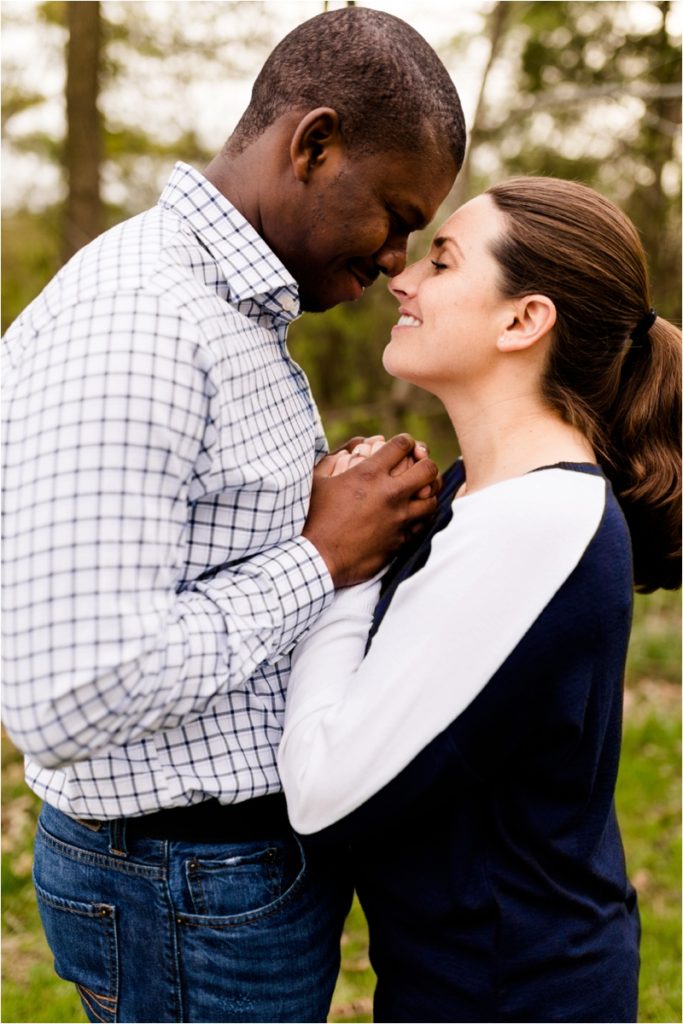
Throughout this guide, we’ve looked into the technical aspects and creative possibilities different lenses offer for engagement photography. As we’ve seen, lens selection significantly defines artistic style and contributes to delivering the exceptional images clients hope for! Bringing these insights together provides actionable recommendations to help us make confident choices for upcoming engagement sessions.
Final Recommendations for Photographers
To create standout engagement photos that couples will treasure, consider building a versatile lens collection that addresses the varied scenarios encountered. Rather than spreading a budget thinly across many average lenses, focusing on acquiring fewer, higher-quality options often yields more consistent, professional results.
Starting Your Lens Kit
For photographers beginning their engagement photography journey, a fast 50mm prime lens (f/1.8 or wider) provides an excellent foundation! This versatile focal length handles everything from environmental portraits to closer compositions while offering great low-light performance. The “nifty-fifty” is frequently suggested as the best-starting lens for engagement photos, especially when budget constraints limit initial options.
As the collection grows, adding an 85mm portrait lens can dramatically elevate the quality and impact of closer compositions. The flattering perspective and lovely bokeh this focal length provides have made it a staple for engagement shooting specialists worldwide! Based on recent performance tests from respected photography publications, options like the Sigma 85mm F1.4 DG DN Art consistently perform well in this category, offering exceptional sharpness and subject isolation.
For those seeking maximum versatility with fewer lens changes, premium zoom lenses like the Sony FE 28-70mm F2 GM offer tremendous flexibility during fast-paced engagement sessions. Recognized as the Zoom Lens of the Year by Amateur Photographer, this lens provides top-notch optical quality and a fast f/2 aperture throughout its range—faster than traditional f/2.8 zooms! This allows for better low-light performance and background separation.
Through years of shooting engagements in countless environments, experience shows that the most consistently successful images often come from understanding not just which lens to use, but when and why to use it. A well-suited lens collection complements a unique shooting style while addressing the specific challenges engagement photographers face—from managing depth of field effectively to capturing authentic interactions in tricky environments!
Encouragement to Test and Experiment with Different Lenses
The journey to finding a personal, perfect engagement photography kit evolves alongside artistic vision. While this guide offers professional recommendations, your unique style might truly flourish with lens combinations others might overlook! The only way to discover these personal preferences is through deliberate experimentation.
Consider renting unfamiliar lenses before purchasing, especially for specialty focal lengths or premium options representing a significant investment. A weekend rental can reveal whether a particular lens genuinely complements your shooting approach before committing substantial funds. Many successful photographers rent first, confirming a lens enhances their creative vision before buying.
The path of lens selection is often one of continuous refinement. What might begin as a collection of budget-friendly options can evolve into a carefully curated kit where each lens serves a specific purpose in a creative workflow. Through this process, we learn that technical specifications, while important, often matter less than how effectively a particular lens helps tell a couple’s unique story.
Ultimately, in engagement photography, technical excellence supports conveying feeling and narrative. The best lens isn’t always the most expensive or technically flawless, but the one that best helps capture the authentic connection between two people celebrating their relationship! By understanding both the science and the application of lens selection, we can create images that couples will value not just for their quality, but for how faithfully they preserve this incredibly meaningful chapter in their lives.
Affiliate Disclosure: Some links in this post are affiliate links, meaning we may earn a commission if you make a purchase through our links, at no extra cost to you. As wedding photographers ourselves, we only recommend gear we’ve thoroughly researched or would use in our own business. Your support helps us continue creating valuable content for the photography community.
